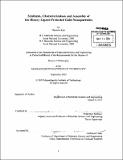| dc.contributor.advisor | Francesco Stellacci. | en_US |
| dc.contributor.author | Kim, Hyewon, Ph. D. Massachusetts Institute of Technology | en_US |
| dc.contributor.other | Massachusetts Institute of Technology. Department of Materials Science and Engineering. | en_US |
| dc.date.accessioned | 2014-07-11T21:06:32Z | |
| dc.date.available | 2014-07-11T21:06:32Z | |
| dc.date.copyright | 2013 | en_US |
| dc.date.issued | 2013 | en_US |
| dc.identifier.uri | http://hdl.handle.net/1721.1/88366 | |
| dc.description | Thesis: Ph. D., Massachusetts Institute of Technology, Department of Materials Science and Engineering, 2013. | en_US |
| dc.description | Cataloged from PDF version of thesis. | en_US |
| dc.description | Includes bibliographical references. | en_US |
| dc.description.abstract | When a gold nanoparticle is coated with two dislike ligands, the ligands selfassemble on the nanoparticle surface and the phase separation occurs based on the miscibility and the size mismatch of two ligands, and the sizes of nanoparticles. When the size of the gold core is approximately between 3-8 nm, the stripe-like ordered domains of two ligands are formed. The stripe-like structure is not favored when you consider only the enthalpy. However, the long ligands obtain extra free-volumes when they are surrounded by the short ligands due to the curvature of a nanoparticle, hence, the entropy increases when two ligands are mixed on the nanoparticle surface. The balance between enthalpy and entropy leads to the state where the stripe-like arrangement of two ligands is thermodynamically the most stable. When the size of the gold core becomes smaller, the entropy contribution becomes less and less relevant, since the gain of free-volume when two different ligands are closely placed is smaller due to the larger curvature of smaller nanoparticles. Under this condition, the final morphology is primarily determined by the enthalpy of separation. Therefore, for small particles, two ligands phase separate into two bulk phases, resulting the Janus nanoparticles. In the first part of this thesis, we demonstrate that gold nanoparticles with a core diameter smaller than 1.5 nm form Janus nanoparticles in many ligand combinations. We used four different nanoparticles and different techniques to confirm the presence of a majority of Janus particles. All of them show similar cut-off sizes for the Janus-to-stripe transition. In the second part of this thesis, we show nanoparticle hydrogels using the selfassembly of the stripe nanoparticles. One of unique surface properties of the stripe nanoparticle is divalency. A particle coated with stripe-like domains implies two defect points at the poles of NPs. These two polar defects can be selectively functionalized with molecules that in turn can act as handles for further assemblies. The network structure is formed only using ionic interaction between NPs, and it requires both divalent anionic nanoparticles and divalent cations. Gels are investigated to determine their properties using rheological characterization. | en_US |
| dc.description.statementofresponsibility | by Hyewon Kim. | en_US |
| dc.format.extent | 100 pages | en_US |
| dc.language.iso | eng | en_US |
| dc.publisher | Massachusetts Institute of Technology | en_US |
| dc.rights | M.I.T. theses are protected by copyright. They may be viewed from this source for any purpose, but reproduction or distribution in any format is prohibited without written permission. See provided URL for inquiries about permission. | en_US |
| dc.rights.uri | http://dspace.mit.edu/handle/1721.1/7582 | en_US |
| dc.subject | Materials Science and Engineering. | en_US |
| dc.title | Synthesis, characterization and assembly of the binary ligand protected gold nanoparticles | en_US |
| dc.type | Thesis | en_US |
| dc.description.degree | Ph. D. | en_US |
| dc.contributor.department | Massachusetts Institute of Technology. Department of Materials Science and Engineering | |
| dc.identifier.oclc | 881179379 | en_US |
